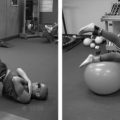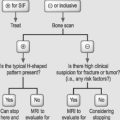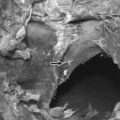CHAPTER 118 Hip Spine Syndrome
INTRODUCTION
Hip and spine syndrome is a condition in which patients experience hip, buttock, and groin pain that concomitantly originates from pathology involving both the spine and the hip. Symptoms of lumbar spondylosis, stenosis, radiculopathy, and facet arthropathy can cause referral of pain to the groin and anterior thigh. Underlying hip pathology may also present with groin and anterior thigh pain. This leads to the clinical dilemma of determining if the patient’s symptoms originate from the hip, spine, or both. Patients may be misdiagnosed with primary hip pathology leading to ineffective management including total joint arthroplasty. They may also be misdiagnosed with lumbar stenosis as the etiology of their lower limb pain and undergo an unnecessary spinal surgery. Difficulty arises when trying to determine the major source of pathology contributing to the patient’s pain and disability. Consequently, clinicians must evaluate both the hip and the spine as possible sources of lower limb pain and weakness.
Lumbar stenosis is a common source of lower limb pain. Approximately 1.2 million people in the United States have back and leg pain that is related to spinal stenosis.1 If lumbar stenosis is the underlying pathology, patients commonly present with complaints of leg pain brought on by standing, walking, or with lumbar extension that increases the lordosis of the spine. They may describe what is termed neurogenic claudication, pain that radiates to the lower extremities and worsens with walking and improves with forward flexion. Severe neurologic symptoms are typically rare.2
Facet arthropathy can cause low back pain with occasional radiation to the buttock, posterior thigh, or knee that worsens with lumbar extension. Pain relief with partial spinal flexion is common.3 Studies carried out by Schwarzer et al. estimate that 15–40% of chronic low back pain is related to facet joint pathology.4,5 In the absence of coexisting pathology, a detailed neurologic examination should be normal.
Biomechanical dysfunction such as muscle imbalance secondary to weakness or flexor contractures of the hip can be the cause of low back pain. An abnormality of the hip joint causes abnormal curvature of the sagittal alignment of the spine and can induce low back or lower limb pain.6 Matsuyama et al. examined the total spinal sagittal alignment in patients with bilateral congenital hip dislocations and found that the most common clinical symptom of the lumbar hyperlordosis found in these patients was low back pain and not lower limb pain.7 Additionally, patients with painful hips from synovitis or chronic inflammatory states may develop a biomechanical dysfunction with secondary effects to the spine.
Osteoarthritis of the hip can present in a similar fashion. In general, osteoarthritis has been radiographically reported in more than 80% of individuals older than 55 years.8 Radiographic evidence of osteoarthritis of the hip has been reported in 12% of patients over the age of 80.9 Osteoarthritis of the spine, hip, or both may result in significant impairment and disability and therefore correct diagnosis is essential for approaching the optimal treatment plan.
Patients with acetabular labral tears often describe ‘deep’ discomfort, most commonly in the anterior groin but occasionally directly lateral, just proximal to the trochanter or deep within the buttocks. Patients may or may not remember a provoking cause of the hip pain. The general complaint is usually discrete episodes of sharp hip pain triggered by pivoting or twisting.10 Lage et al. reported the incidence of idiopathic and degenerative acetabular labral tears to be 27.1% and 48.6%, respectively.11
Vascular disease is a widely reported phenomenon. It is estimated that up to 12% of the population older than 66 years of age has peripheral vascular disease.12 In many ways, the symptomatology of vascular disease mimics that of hip and lumbar spine pathology. Intermittent claudication secondary to peripheral arterial disease has been commonly described as a pain felt in the calf of the leg. It is brought on by walking, relieved by rest, and described as ‘heaviness,’ ‘cramping,’ or ‘tiredness in the legs.’13 Less frequently, patients may complain of pain in the thigh, buttock, groin, or lower back without associated calf pain as can be seen with common iliac artery obstruction.14 The presence of these symptoms is sometimes coupled with numbness in the foot which results from ischemia of peripheral nerves. The least appreciated symptom associated with severe vascular disease is rest pain.15 It may be intermittent or continuous in nature and it is not made worse with exercise. It characteristically occurs at night when the affected limb is elevated and cardiac output and blood pressure fall. Rest pain is typically relieved when the patient gets up and walks as perfusion improves.16,17
TYPES
‘Simple hip spine syndrome’ occurs when the pain generator is easily determined to be coming from either the hip or the spine exclusively.6 Once the appropriate treatment is instituted, the patient should then have significant relief.
‘Complex hip spine syndrome’ is not as clearly differentiated when both the hip and the spine are contributing to a patient’s discomfort.6 Further differential testing including a comprehensive physical examination as well as other radiologic or interventional diagnostic procedures must be done to find the major structure involved.
In ‘secondary hip spine syndrome,’ the hip and spine are not distinct entities, and dysfunction with one causes abnormalities with the other. This syndrome can arise from hip flexor contractures placing the spine in excessive hyperlordosis by forward rotation of the pelvis. This increased curvature affects the facet joints, with slippage of the posterior facet joint increasing foraminal stenosis and creating nerve root impingement. Concomitant nerve root involvement with hip osteoarthritis can worsen an already weak hip.6 Difficulty arises when determining the greater offender and the ultimate treatment course.
CLINICAL PRESENTATION
The assessment of strength must be performed in a sequential manner, evaluating muscle groups innervated by different peripheral nerves and nerve roots. The strength examination should include the assessment of hip flexors (L1–3), quadriceps (L2–4), tibialis anterior (L4–5), extensor hallucis longus and hip abductors (L5), and the gastrocnemius/soleus complex (S1). Johnsson reported on 163 cases of lumbar spinal stenosis and found that extensor hallicus longus and peroneal paresis were the most common signs.2 L4 nerve root irritation may lead to a diminished patella reflex and can create pain that typically radiates to the anterior knee and not necessarily below the knee. The straight leg raise, sitting root, and femoral nerve stretch tests provide evidence of nerve root irritation. Lower limb symmetry should be carefully assessed, as asymmetric muscle bulk and the presence of muscle fasciculations portend a neurologic component. Asymmetric muscle strength is often subtle in patients with radiculopathies. Single-leg partial squats and single-leg standing heel raises can assess the functional strength of the quadriceps and calf muscles, respectively.
Anterior acetabular labral tears may be detected by moving the hip from a position of full flexion, external rotation, and abduction to a position of extension, internal rotation, and adduction. Conversely, moving the hip from a position of full flexion, adduction, and internal rotation to a position of extension, abduction, and external rotation allows detection of posterior labral tears.18 Hase and Ueo reported that all patients with acetabular labral tears had pain with axial compression upon a 90° flexed and slightly adducted hip.19
Identification of peripheral vascular disease requires blood pressure recordings taken in both limbs, pulses checked on each side, and bruits auscultated for over the major peripheral arteries of both the upper and lower limbs.20 Absence of hair growth on the dorsum of the foot and toes, particularly when it was formerly present, suggests arterial insufficiency.21 Femoral pulses should be palpated and timed with the radial pulses. Other pulses can be assessed and compared in the same manner. Temperature gradients in each limb ought to be assessed. The palm of the hand should be used moving across the limb in a proximal to distal fashion. A cold foot with warm knees is characteristic of popliteal arterial obstruction.14 Simply reporting whether a pulse is present, reduced, absent, or aneurysmal in nature provides less subjectivity than using scales composed of too many gradations. Limb color should be evaluated with the limbs elevated, then with the limbs hanging off the edge of the examination table. A healthy, elevated limb will show mild blanching, whereas an elevated ischemic limb will appear appreciably paler.22 As the limbs are brought into a gravity-dependent position, the ischemic limb will appear redder. Severe ischemic disease will result in dependent rubor. The proximal extent of the rubor is directly related to the severity of the arterial insufficiency.23 Of note, rubor is typically seen in patients with rest pain.14 Assessment of the vascular system after exercise will regularly give rise to an unsuspected diagnosis in patients where there is doubt about the presence or absence of peripheral arterial disease. A poorly perfused limb after exercise will be much paler, with collapsed veins. The patient can exercise the legs by actively dorsiflexing and plantarflexing for 30–60 seconds.21
DIAGNOSTIC AIDS
Plain radiographs have generally been utilized to assess the presence of severe hip osteoarthritis. Plain radiographs in patients with only acetabular labral pathology are typically negative. While arthroscopy is the gold standard for diagnosing acetabular labral tears, MRI arthrography is currently the most sensitive nonsurgical test. MRI alone appears to be less sensitive than arthrography alone for diagnosing acetabular labral tears. Hase and Ueo demonstrated an accurate diagnosis of acetabular labral tears in 37% of their patients tested using arthrography alone. However, they were unable to confirm a tear in any of their patients examined with MRI alone. Arthroscopy was used as the definitive measure to confirm their findings.19 Petersilge et al. found complete correlation between MRI arthrography and arthroscopy in diagnosing acetabular labral tears.24
Employing minimally invasive diagnostic procedures including epidural nerve root or hip joint injections has proven to be invaluable in assessing the involvement of each area to the patient’s diagnosis. A minimally invasive fluoroscopically guided injection to the hip joint or nerve root can easily and safely be performed with diagnostic and therapeutic benefit. Following the procedure, the patient should be taken through those activities that would normally reproduce or exacerbate their symptoms. A careful assessment of the patient’s response will assist in identifying the area of inciting pathology. Kleiner et al. described the identification of the hip as the source of pain in 88% of cases after injection of 10 mL of bupivacaine HCl to the hip joint.25 If no relief is provided with a hip injection, a closer look should be given to the spine. There are several diagnostic blocks that can be performed to the spine to evaluate and treat the pain etiology. Lumbar facet and medial branch blocks or epidural injections via interlaminar, transforaminal, or caudal approaches can be done. If there is significant relief, the spine is the likely contributor of the pain.
Infrequently, low back and lower limb symptoms may be the result of an occult process. Kleiner et al. reported on 12 cases of misdiagnosis. Ten patients were initially diagnosed with having an L3 and/or L4 or S1 radiculopathy. Two patients were referred with an initial diagnosis of sciatic neuropathy. All patients had failed various therapeutic measures aimed at correcting their initial diagnoses, including two patients who underwent laminectomies without resolution of their symptoms. Further investigation uncovered occult malignancies in nine patients. A hematoma, an aneurysm of the obturator artery, and a neurilemmoma of the sciatic nerve were discovered in the remaining three. The authors note that the most useful means of identifying the correct diagnosis was computed tomography or MRI of the abdomen and pelvis.25
1 Hart LG, Deyo RA, Cherkin DC. Physician office visits for low back pain. Frequency, clinical evaluation, and treatment patterns from a US national survey. Spine. 1995;209(1):11-19.
2 Johnsson KE. Lumbar spinal stenosis. A retrospective study of 163 cases in southern Sweden. Acta Orthop Scand. 1995;66(5):403-405.
3 Dreyer SJ, Dreyfuss P. Low back pain and the zygapophyseal joints. Arch Phys Med Rehabil. 1996;77(3):290-300.
4 Schwarzer AC, Aprill CN, Derby R, et al. The relative contributions of the disc and zygapophyseal joint in chronic LBP. Spine. 1994;19(7):801-806.
5 Schwarzer AC, Wang S, O’Driscoll D, et al. The ability of computed tomography to identify a painful zygapophyseal joint in patients with chronic low back pain. Spine. 1995;20(8):907-912.
6 Offierski CM, Macnab I. Hip-spine syndrome. Spine. 1983;89(3):316-321.
7 Matsuyama Y, Hasegawa Y, Yoshihara H, et al. Hip-spine syndrome: total sagittal alignment of the spine and clinical symptoms in patients with bilateral congenital hip dislocation. Spine. 2004;29(21):2432-2437.
8 Fogel GR, Esses SI. Hip spine syndrome: management of coexisting radiculopathy and arthritis of the lower extremity. Spine J. 2003;3(3):238-241.
9 Lawrence RC, Helmick CG, Arnett FC, et al. Estimate of the prevalence of arthritis and selected musculoskeletal disorders in the United States. Arthritis Rheum. 1998;41(5):778-799.
10 Fitzgeraled RH. Acetabular labral tears. Diagnosis and treatment. Clin Orthop. 1995;311:60-68.
11 Lage LA, Patel JV, Villar RN. The acetabular labral tear: an arthroscopic classification. Arthroscopy. 1996;12(3):269-272.
12 Pandian G, Hamid F, Hammond MC. Rehabilitation of the patient with PVD and diabetic foot problems. In: Delisa J, Gans BM, editors. Rehabilitation medicine: principles and practice. Philadelphia: Lippincott-Raven; 1998:1517-1544.
13 Zabalgoitia M, O’Rourke RA. Disease of the aorta. In: Stein HL, editor. Internal medicine. 4th edn. St. Louis: Mosby; 1994:285-293.
14 Provan JL, Moreau P, MacNab I. Pitfalls in the diagnosis of leg pain. Can Med Assoc J. 1979;121(2):167-171.
15 Cranley JJ. Ischemic rest pain. Arch Surg. 1969;98(2):187-188.
16 Rutherford RB. Initial patient evaluation. In: Rutherford RB, editor. Vascular surgery. 5th edn. Philadelphia: WB Saunders; 2001:1-13.
17 Craeger MA, Libby P. Peripheral arterial disease. In: Braunwald E, Zipes DP, Libby P, editors. Heart disease: a textbook of cardiovascular medicine. 6th edn. Philadelphia: WB Saunders; 2001:1457-1484.
18 Huffman G, Safran M. Tears of the acetabular labrum in athletes: diagnosis and treatment. Sports Med Arthroscopy Rev. 2002;10(2):141-150.
19 Hase T, Ueo T. Acetabular labral tear: arthroscopic diagnosis and treatment. Arthroscopy. 1999;15(2):138-141.
20 Braunwald E, Perloff JK. Physical examination of the heart and circulation. In: Braunwald E, Zipes DP, Libby P, editors. Heart disease: a textbook of cardiovascular medicine. 6th edn. Philadelphia: WB Saunders; 2001:45-81.
21 Arnold GJ. Peripheral vascular assessment: history taking and physical examination of the arterial and venous system. In: Abela GS, editor. Peripheral vascular disease: basic diagnostic and therapeutic approaches. Philadelphia: Lippincott Williams and Wilkins; 2004:37-52.
22 Seidel HM, Ball JW, Dains JE, et al. Mosby’s guide to physical examination, 5th edn. St. Louis: Mosby, 2003.
23 Spittell PC, Spittell JAJr. Diseases of the peripheral arteries and veins. In: Stein JH, editor. Internal medicine. 4th edn. St. Louis: Mosby; 1994:293-302.
24 Petersilge CA, Haque MA, Petersilge WJ, et al. Acetabular labral tears: evaluation with MR arthrography. Radiology. 1996;200(1):231-235.
25 Kleiner JB, Donaldson WFIII, Curd JG, et al. Extraspinal causes of lumbosacral radiculopathy. J Bone Joint Surg [Am]. 1991;73(6):817-821.







